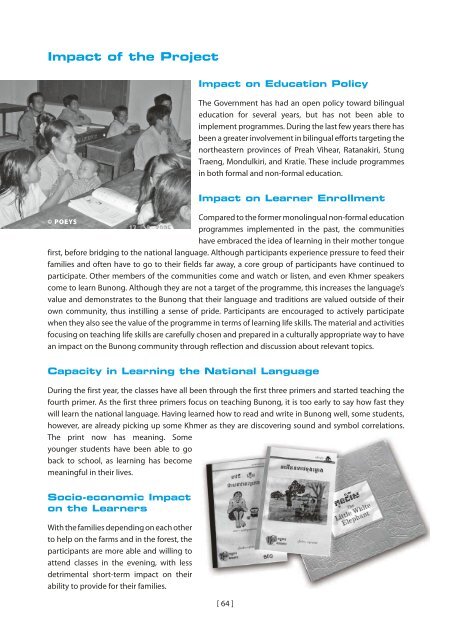Mother Tongue-based Literacy Programmes: Case Studies of Good ...
Mother Tongue-based Literacy Programmes: Case Studies of Good ...
Mother Tongue-based Literacy Programmes: Case Studies of Good ...
You also want an ePaper? Increase the reach of your titles
YUMPU automatically turns print PDFs into web optimized ePapers that Google loves.
Impact <strong>of</strong> the ProjectImpact on Education PolicyThe Government has had an open policy toward bilingualeducation for several years, but has not been able toimplement programmes. During the last few years there hasbeen a greater involvement in bilingual efforts targeting thenortheastern provinces <strong>of</strong> Preah Vihear, Ratanakiri, StungTraeng, Mondulkiri, and Kratie. These include programmesin both formal and non-formal education.Impact on Learner EnrollmentCompared to the former monolingual non-formal education© POEYSprogrammes implemented in the past, the communitieshave embraced the idea <strong>of</strong> learning in their mother tonguefirst, before bridging to the national language. Although participants experience pressure to feed theirfamilies and <strong>of</strong>ten have to go to their fields far away, a core group <strong>of</strong> participants have continued toparticipate. Other members <strong>of</strong> the communities come and watch or listen, and even Khmer speakerscome to learn Bunong. Although they are not a target <strong>of</strong> the programme, this increases the language’svalue and demonstrates to the Bunong that their language and traditions are valued outside <strong>of</strong> theirown community, thus instilling a sense <strong>of</strong> pride. Participants are encouraged to actively participatewhen they also see the value <strong>of</strong> the programme in terms <strong>of</strong> learning life skills. The material and activitiesfocusing on teaching life skills are carefully chosen and prepared in a culturally appropriate way to havean impact on the Bunong community through reflection and discussion about relevant topics.Capacity in Learning the National LanguageDuring the first year, the classes have all been through the first three primers and started teaching thefourth primer. As the first three primers focus on teaching Bunong, it is too early to say how fast theywill learn the national language. Having learned how to read and write in Bunong well, some students,however, are already picking up some Khmer as they are discovering sound and symbol correlations.The print now has meaning. Someyounger students have been able to goback to school, as learning has becomemeaningful in their lives.Socio-economic Impacton the LearnersWith the families depending on each otherto help on the farms and in the forest, theparticipants are more able and willing toattend classes in the evening, with lessdetrimental short-term impact on theirability to provide for their families.[ 64 ]

















